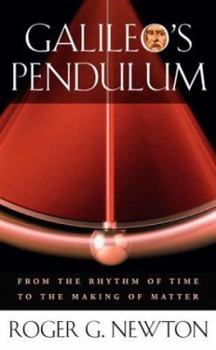Galileo's Pendulum: From the Rhythm of Time to the Making of Matter
Select Format
Select Condition 
Book Overview
Bored during Mass at the cathedral in Pisa, the seventeen-year-old Galileo regarded the chandelier swinging overhead - and remarked, to his great surprise, that the lamp took as many beats to complete an arc when hardly moving as when it was swinging widely. Galileo's Pendulum tells the story of what this observation meant, and of its profound consequences for science and technology. The principle of the pendulum's swing - a property called isochronism...
Format:Hardcover
Language:English
ISBN:067401331X
ISBN13:9780674013315
Release Date:March 2004
Publisher:Harvard University Press
Length:153 Pages
Weight:0.70 lbs.
Dimensions:0.7" x 5.4" x 8.0"
Customer Reviews
2 ratings
Galileo's Pendulum
Published by Thriftbooks.com User , 18 years ago
Galileo's Pendulum: From the Rhythm of Time to the Making of Matter In Galileo's Pendulum, Robert G. Newton provides a concise and fascinating discussion of how the accurate measure of time spurred mankind on to some of its most remarkable scientific discoveries. Newton begins his book by surveying the earliest attempts to measure time, beginning with the civilizations of the ancient Near East. The measuring of days, months, and years led to more complex endeavors to get a hold on time. But for Newton, the discovery by a young medical student named Galileo in 1581 of the time measuring properties of a swinging pendulum was the seminal event. That discovery provided scientist with a measuring means that enabled them to construct clocks and then watches, that became vital to the measuring of sound and light waves that eventually lead to quantum physics. Newton launches from Galileo's insight into an explanation of the inventions and intellectual ideas it gave birth to with an ease that compels the reader's attention as it must have the author's. Anyone wanting to understand the importance of time, not only to our routine daily lives but as the underpinning of many of the scientific discoveries that facilitate our lives and inspire us to dream about the secrets of the universe, is advised to read this book.
Simple Harmonic Oscillators Through the Centuries
Published by Thriftbooks.com User , 20 years ago
Like so many stories about Galileo, his flash-of-inspiration about pendulums is an unverifiable legend, but it is a great one. Bored by mass in the cathedral of Pisa, he started watching the chandelier hanging from a long chain, and timing it with the best clock he had available, his own pulse. Maybe he wasn't the first one to notice this, or to wonder about it, but the pendulum blown by drafts took as long to swing back and forth whether it was making a big arc or a small one. The observation was not exactly true, and his means of measuring it were not exact, and maybe the whole thing didn't happen anyway. Nonetheless, Galileo did discover a secret about pendulums that has profoundly affected physics and the whole world ever since. In _Galileo's Pendulum; From the Rhythm of Time to the Making of Matter_ (Harvard University Press), Roger G. Newton has started from this very first observation of a "simple harmonic oscillator" and briskly traced the concept up through quantum theory. The book contains some daunting math, which the author invites those so inclined to skip, but has scientific history and a summary of physics that is exhilarating and clear. A simple harmonic oscillator (SHO) is only deceptively simple. It can be completely understood mathematically, but gives enough complexity in its variants to be eternally interesting. The most obvious SHO, the pendulum, has its most famous use in clocks, and there are four chapters here on the history of clock-making. It was Galileo himself who, having noticed the regularity of the pendulum swing, realized that a pendulum would be the perfect timer to regulate a clock. He himself designed an escapement for such a pendulum, but only after his death did the design get put into action. Pendulum clocks had their problems, as readers of _Longitude_ know. The coiled balance spring of clocks that could be used aboard ship has, via its elastic properties, the same oscillation potential as a pendulum. Eventually clocks were regulated by tuning forks; the tines of the fork, too, show SHO. Even better results came from electrically vibrating a quartz crystal at millions of times a second, another SHO. Crystals do slowly age, and their periodicity eventually varies, but electrons do not. Atomic clocks, which are more accurate even than the rotations and revolutions of the Earth which clocks are supposed to measure, are based on the frequency of electromagnetic waves emitted when cesium electrons are excited. Having brought clocks into the quantum realm, the author goes back to trace the physics of oscillation. It was Isaac Newton with his laws of motion who explained why a pendulum acted the way it did, and enabled its motion to be mathematically evaluated. The movement and forces on a pendulum can be graphed, and show up as sinusoidal waves, which are observed all over the place in nature. Fourier discovered that time functions, even if they weren't sinusoidal, could be expressed as sums of different s





